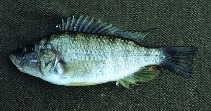| Diagnosis: |
Dorsal spines (total): 14-14; Dorsal soft rays (total): 8-8. Diagnosis: Head with conspicuous irregular dark marks (Ref. 4967). Description: Dorsal fin with 14 spines and 8 rays; scales on lateral line 28, transverse scales 4/9 (Ref. 127080). Teeth bicuspid, cusps subequal, slightly tinged with brown; 28-31 each side of upper jaw outer series (Ref. 127080). Cheeks naked or few extremely thin scales; eye diameter nearly equal to depth of soft part of cheek, a little less than width of preorbital and interorbital space, which is flat (Ref. 127080). Preopercular limbs at right angle; body height less than length of head, and one third of total length (without caudal) (Ref. 127080). Last spine longest, two fifths of head length; pectoral finto, or nearly to, origin of anal fin; caudal scaleless (Ref. 127080). Scales rough, some with margins ciliated (Ref. 127080). Colouration: Body light greenish, with incomplete brownish cross-bands on upper part of body; cheek and snout with irregular deep brown spots; soft dorsal and caudal fin with scattered ocelli; milky-white spot between last two anal rays (Ref. 127080). |

